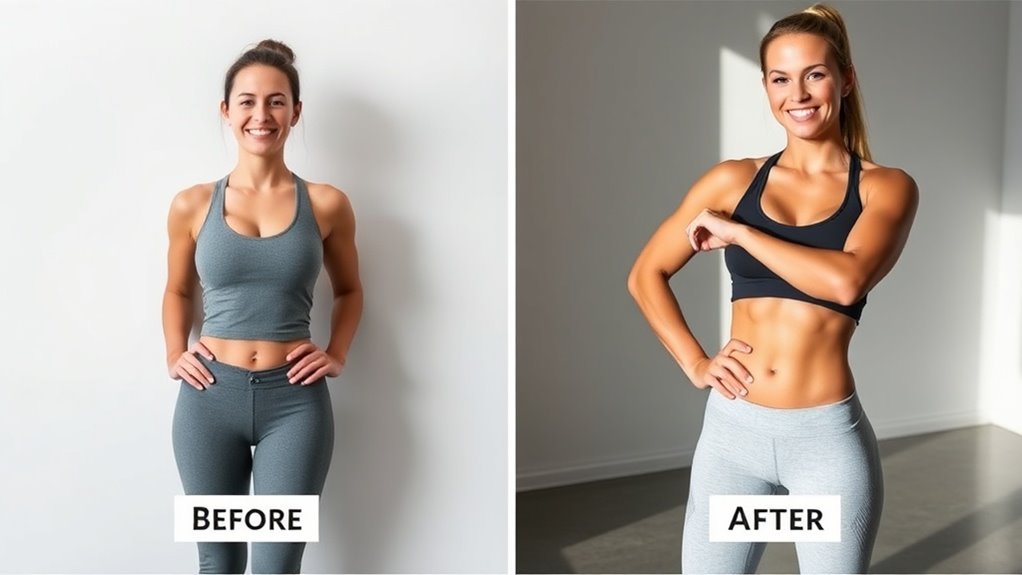How One Woman Lost 20 Pounds Without a Gym
Have you ever wondered if shedding pounds without a gym is truly possible? You can achieve it by tracking your daily calories and setting simple, realistic goals, much like one woman who lost 20 pounds through mindful habits. As you consider these practical steps, you’ll see how they build lasting change.
My Weight Loss Motivation
Motivation fueled my journey to lose 20 pounds, starting with a clear-eyed look at how excess weight affected my health.
You recognize that weight loss without gym is achievable through evidence-based lifestyle tweaks, like improving diet and activity at home.
Studies show that motivation thrives when you focus on health risks, such as increased heart disease probability, prompting practical changes.
You’re empowered by research-backed habits: tracking calories boosts adherence, while incorporating whole foods enhances satiety and metabolism. Food journaling increases awareness of eating choices and helps you identify patterns in your eating habits.
This educational approach makes weight loss without gym sustainable and effective for you.
Setting Achievable Goals
You’ve got to begin by defining clear goals for your weight loss, such as specifying exactly what you aim to achieve and by when.
This approach helps you track progress and stay motivated, drawing from strategies that studies show boost success rates.
Next, set realistic targets that align with your daily life, ensuring they’re challenging yet attainable to avoid frustration and build lasting habits.
Additionally, setting realistic goals is essential for sustainable progress and maintaining a positive mindset throughout your weight loss journey.
[LIST OF 3 SUBHEADING DISCUSSION POINTS IN ENGLISH
When setting achievable goals for weight loss, it’s essential to focus on three key strategies: first, define specific targets like losing one pound per week; second, make them measurable by tracking progress with a journal; and third, ensure they’re realistic based on your current lifestyle and resources. To evoke the emotional transformation, compare your journey like this:
| Before Goal Setting | After Achieving Milestones |
|---|---|
| Overwhelmed by doubt | Empowered with confidence |
| Frustrated and stuck | Motivated and progressing |
| Anxious about failure | Proud of small wins |
| Disheartened routine | Joyful in new habits |
| Isolated in struggle | Supported by progress |
You track changes actively, fostering emotional resilience and sustained success.
Define Clear Goals
Setting clear goals is the cornerstone of effective weight loss, as it transforms vague intentions into actionable steps you can track and achieve.
Start by making your goals specific and measurable, like aiming to walk 10,000 steps daily rather than just “exercising more.” Research from the American Psychological Association shows that well-defined goals boost motivation and adherence.
You’ll break them into daily tasks, using a journal to monitor progress, which keeps you accountable. This approach empowers you to stay focused, turning aspirations into tangible wins without overwhelming complexity.
Set Realistic Targets
Achieving realistic targets is key to sustainable weight loss, as they prevent frustration and build long-term habits. You set them by assessing your current lifestyle and breaking goals into small, actionable steps, backed by research showing gradual changes boost adherence. For instance, aim for sustainable progress rather than overnight transformations.
| Goal Type | Unrealistic Example | Realistic Alternative |
|---|---|---|
| Weight Loss | Drop 10 pounds in one week | Lose 1-2 pounds per week |
| Exercise | Run 5 miles every day | Walk 30 minutes, 3 days a week |
| Diet Changes | Cut out all sweets forever | Limit sweets to once a day |
This method, per studies, keeps you motivated and successful.
Daily Calorie Awareness
You track your daily calorie intake using a simple app or journal to see exactly what you’re consuming. Next, you calculate your calorie needs based on factors like age, weight, and activity level to set a realistic target. Then, you choose nutrient-dense foods that fit within your calorie goals for sustainable weight loss. Additionally, incorporating drinking water before meals can help curb appetite and promote a sense of fullness, further supporting your weight loss journey.
Track Daily Intake
Tracking daily calorie intake forms the cornerstone of effective weight loss, as it reveals patterns in consumption that directly influence energy balance.
You can start by logging everything you eat using a simple app or journal, which research from the American Journal of Preventive Medicine shows increases awareness and reduces intake by up to 20%.
This practice helps you spot hidden calories in snacks or drinks, empowering better choices like opting for veggies over chips.
By reviewing your logs daily, you’re building habits that promote sustainable change, making weight loss feel achievable and less overwhelming.
Stay consistent, and you’ll see progress.
Calculate Calorie Needs
After tracking your daily intake, calculating your calorie needs ensures you’re creating a sustainable deficit for weight loss.
To do this, first determine your Basal Metabolic Rate (BMR) using the Harris-Benedict equation, which factors in age, sex, weight, and height.
Then, multiply by an activity factor to get Total Daily Energy Expenditure (TDEE), reflecting your lifestyle.
Evidence shows a 500-calorie daily deficit promotes steady loss without muscle loss or fatigue.
Use reliable online calculators for accuracy, and adjust periodically as your weight changes to maintain health and progress effectively.
Consult a professional for personalized advice.
Choose Calorie Options
Choosing the right calorie options helps maintain a daily deficit without sacrificing nutrition. You can achieve this by focusing on nutrient-dense foods that fill you up without excess calories. Track your intake using apps or journals to stay aware daily, ensuring you hit your goals while getting essential vitamins.
| Food Category | Calories per Serving (100g) | Key Benefits |
|---|---|---|
| Leafy Greens | 20-50 | High in fiber and vitamins for satiety |
| Berries | 50-80 | Antioxidants aid metabolism and health |
| Lean Proteins | 100-150 | Builds muscle, promotes fullness |
| Whole Grains | 100-150 | Provides sustained energy |
| Nuts/Seeds | 500-600 | Healthy fats support heart health |
Simple Kitchen Makeovers
While revamping your kitchen can feel overwhelming, simple changes make healthy eating effortless and support weight loss goals.
Start by decluttering counters to create space for fresh fruits and veggies, which studies show increases consumption by making them more visible.
Swap out sugary snacks for nuts and seeds in easy-to-reach spots, reducing impulse eating by 20-30%, per research.
Use smaller plates to control portions—evidence from behavioral studies confirms this cuts calorie intake. Incorporating portion control practices helps manage intake without feeling deprived.
Invest in a blender for quick, nutrient-dense smoothies, turning your kitchen into a weight loss ally without major expense or effort.
Building a Balanced Meal Plan
Creating a balanced meal plan doesn’t have to be complicated—it empowers you to fuel your body effectively for sustained weight loss.
Start by assessing your daily calorie needs using evidence-based calculators, then divide your plate into portions: half for vegetables, a quarter for lean proteins, and a quarter for whole grains.
This approach, supported by studies on metabolic health, helps maintain steady energy levels and prevents overeating. Tracking your meals in a journal to adjust portions dynamically ensures you hit your macros without counting every bite. Additionally, meal planning not only aids in making healthier food choices but also reduces the temptation for fast food.
Nutrient-Rich Food Choices
To maximize your weight loss results, focus on nutrient-rich foods that deliver essential vitamins, minerals, and antioxidants without excess calories.
These choices fuel your body, curb cravings, and support metabolism, as studies show they enhance satiety and health.
Here’s how to incorporate them practically:
-
Prioritize vegetables: Load up on broccoli and kale for fiber and vitamins, reducing calorie intake while boosting immunity.
-
Embrace fruits: Pick apples or blueberries for natural sugars and antioxidants, aiding inflammation control and energy.
-
Incorporate whole grains: Choose oats or quinoa over refined carbs for sustained energy and better blood sugar regulation.
-
Add lean proteins*: Select eggs or beans to build muscle and *promote fullness, enhancing your weight loss journey.
Additionally, focusing on a balanced diet is essential for preventing long-term health issues that extreme dieting can cause.
Hydration Strategies for Success
Proper hydration is essential for your weight loss efforts, as it boosts metabolism and helps control appetite by signaling fullness.
To optimize this, aim for at least 64 ounces of water daily, backed by studies showing it enhances fat burning. Drink a glass before meals to reduce hunger and calorie intake, as research indicates this promotes satiety. Drinking water before meals also helps curb appetite and encourages healthier food choices.
Infuse water with lemon or cucumber for better taste and nutrient absorption, making hydration enjoyable.
Track your progress by monitoring urine color—pale yellow signals adequate intake—and set reminders to sip regularly, ensuring sustained energy and weight loss success.
Easy Home Exercise Routines
You’ll find that bodyweight basics form the foundation of effective home exercises, helping you build strength without needing equipment.
It’s simple to incorporate quick daily routines into your schedule for consistent calorie burn.
These straightforward home workouts, backed by fitness research, make it easier to achieve lasting weight loss results.
Bodyweight Basics
Whether you’re easing into fitness or refining your routine, bodyweight exercises provide an accessible way to build strength and support weight loss right at home.
These routines use your own body as resistance, making them effective for toning muscles and boosting metabolism, as supported by studies on functional training.
-
Master squats: Engage your quads and glutes by lowering into a seated position, improving lower body power and calorie burn.
-
Try push-ups: Target your chest and arms by pushing up from the floor, enhancing upper body strength and endurance.
-
Hold planks: Activate your core by maintaining a straight line from head to heels, which stabilizes posture and aids fat loss.
-
Incorporate lunges: Step forward to work your legs and balance, promoting functional movement and overall conditioning.
Quick Daily Routines
Incorporating quick daily routines into your busy schedule boosts fitness without overwhelming demands, drawing on research that shows short, consistent exercises enhance metabolism and sustain weight loss.
You’ll find that 10-minute sessions, like brisk walking or bodyweight squats, build habits backed by studies from the American Council on Exercise, improving cardiovascular health efficiently.
For instance, aim for three daily sets of jumping jacks or wall pushes; these routines, as per Harvard Health research, increase calorie burn without equipment.
Track your progress to stay motivated, ensuring long-term adherence and steady results in your weight-loss journey.
Simple Home Workouts
Simple home workouts make fitness achievable right in your living room, drawing on research from the American College of Sports Medicine that shows bodyweight exercises like push-ups and planks build strength and burn calories efficiently.
You’ll boost your metabolism and shed pounds by focusing on consistency and proper form, as studies confirm these routines enhance endurance without equipment.
To get started, try these evidence-based exercises:
-
Push-ups: Strengthen your chest and arms with three sets of 10-15 reps, improving upper body power per ACSM guidelines.
-
Planks: Hold for 20-30 seconds to build core stability, reducing injury risk as supported by fitness research.
-
Squats: Perform 15 reps to tone legs and glutes, enhancing lower body strength for daily activities.
-
Jumping jacks: Do 1-2 minutes for cardio, increasing heart health and calorie burn as per exercise science.
DIY Fitness Equipment Ideas
Creating your own fitness equipment at home doesn’t require fancy tools; you can repurpose everyday items like water bottles for weights or sturdy chairs for step-ups, making workouts accessible and cost-effective while supporting your weight loss journey.
For instance, fill water bottles with sand for added resistance during bicep curls, which builds muscle and boosts metabolism—backed by studies showing strength training aids fat loss.
Use a backpack filled with books for squats, engaging multiple muscle groups for better results.
Always check item stability to prevent injury, ensuring safe, effective home routines that enhance your progress.
Walking and Movement Hacks
You’ve likely found that incorporating daily walking hacks into your routine boosts calorie burn and supports weight loss, just as they did for the woman in this story.
By weaving movement integration tips into everyday activities, like taking stairs or pacing during calls, you’re effortlessly increasing your physical activity.
Finally, applying step boost strategies, such as setting incremental goals, helps you track progress and achieve sustainable results.
Daily Walking Hacks
While daily walking might seem straightforward, integrating smart hacks into your routine can amplify its weight-loss benefits, as evidenced by studies showing that even 30 minutes of brisk walking daily boosts calorie burn and metabolism.
Here are four practical hacks to optimize your walks:
-
Incorporate intervals: Alternate between fast and moderate paces to spike your heart rate, increasing calorie expenditure by up to 20%, according to fitness research.
-
Vary your terrain: Choose hills or uneven paths to engage more muscles, enhancing fat loss as demonstrated in terrain-based studies.
-
Track your steps: Use a simple pedometer to aim for 8,000–10,000 steps daily, which correlates with sustained weight reduction in longitudinal trials.
-
Focus on form: Swing your arms actively and maintain upright posture to burn extra calories and prevent strain, supported by biomechanical evidence.
Movement Integration Tips
To enhance your weight-loss efforts beyond daily walks, consider integrating simple movement hacks that blend seamlessly into your routine, as studies show these additions can boost calorie burn by up to 15% through varied activities like stair climbing or desk-side stretches.
For instance, opt for stairs over elevators; you’ll engage more muscles and improve heart health, per research in the Journal of Applied Physiology.
During work breaks, try standing desk exercises—you’re burning extra calories while reducing sedentary time.
These hacks, backed by fitness studies, make movement habitual, enhancing metabolism without disrupting your day.
Stay consistent for results.
Step Boost Strategies
Boost your daily steps by incorporating simple, research-backed hacks that elevate your walking routine and overall activity levels.
Studies from the American Journal of Preventive Medicine show these methods increase daily movement, aiding weight loss like our featured woman’s journey.
-
Track your steps: Use a wearable device; research indicates it boosts activity by 20-30% through real-time feedback.
-
Park farther: Choose spots away from entrances, adding 1,000+ steps daily, as per urban health studies.
-
Incorporate intervals: Alternate walking speeds to burn more calories, supported by exercise physiology research.
-
Walk during breaks: Stand and pace during calls or TV ads, enhancing NEAT (non-exercise activity thermogenesis) per NIH findings.
Morning Energy Boosters
Kicking off your day with the right energy boosters sets a positive tone for weight loss success. You can start by drinking a full glass of water upon waking, which rehydrates your body and boosts metabolism—research shows it enhances alertness and fat burning.
Next, take a brief outdoor walk; natural light exposure regulates your circadian rhythm, increasing energy as per studies on light therapy. Incorporate deep breathing exercises; they improve oxygen flow and lower stress hormones, promoting mental clarity based on mindfulness research.
Finally, add simple stretches; they enhance circulation and prepare your body for activity. Make these habits routine for sustained vitality.
Mindful Eating Techniques
You can enhance your weight loss journey by chewing slowly, which research shows helps you consume fewer calories and improve digestion.
Savoring flavors lets you fully appreciate your food, reducing the urge to overeat during meals.
Incorporating these mindful techniques into your routine makes eating a more intentional and effective part of your health strategy.
Chew Slowly
Chewing slowly helps you tune into your body’s hunger signals, making it easier to eat mindfully and avoid excess calories. This technique enhances digestion and promotes satiety, as studies show it allows hormones like leptin to signal fullness effectively.
You’ll reduce intake without feeling deprived.
-
Count chews: Aim for 20-30 per bite to break down food thoroughly, improving nutrient absorption.
-
Pause between bites: Put down your fork to assess hunger, preventing mindless eating.
-
Minimize distractions: Eat without screens to stay focused on the eating process.
-
Track progress: Log meals to monitor how slowing down affects your portions and energy levels.
Savor Flavors
Savoring flavors during meals heightens your awareness of food’s taste and texture, fostering a deeper connection to what you’re eating.
Research shows this technique, rooted in mindfulness, helps you recognize fullness faster, cutting calorie intake by up to 20% in studies.
To practice, pause between bites, identify subtle notes like sweetness in berries or spice in herbs, and engage all senses—smell, sight, and feel.
You’ll eat slower, enjoy portions more, and avoid mindless snacking, as one woman did by transforming meals into intentional experiences, leading to sustainable weight loss without gym reliance.
Weekly Progress Tracking
Weekly progress tracking keeps your weight loss efforts on course by providing clear, measurable insights into your progress.
You’ll identify trends in your eating and activity, allowing quick tweaks for better results, backed by studies showing regular monitoring boosts success rates.
-
Weigh yourself weekly: Use a reliable scale on the same day and time to track trends accurately.
-
Log your meals: Record food intake to spot patterns in calories and nutrients.
-
Track physical activity: Note steps or exercise duration to ensure consistency.
-
Review metrics: Compare weekly data against goals to refine your strategy effectively.
Breaking Through Challenges
While weight loss journeys often hit roadblocks like plateaus or motivation dips, you can overcome them by applying proven strategies that research supports.
To break through plateaus, tweak your routine based on tracking data; studies show varying exercises boosts metabolism.
For motivation dips, set specific, achievable goals—research from the American Psychological Association confirms this reignites drive. Track small wins daily to build momentum, and seek accountability from a buddy, as social support enhances adherence per behavioral studies.
Stay consistent; these tactics helped one woman push past hurdles and reach her goals.
The Power of Rest and Recovery
Rest and recovery aren’t just breaks in your routine—they’re essential for sustainable weight loss, as research shows that adequate sleep and downtime help regulate hormones like cortisol and ghrelin, which control appetite and metabolism.
You build resilience by making rest a priority, ensuring your body repairs and optimizes fat loss.
To integrate this effectively:
-
Target 7-9 hours of sleep nightly, as studies link it to better metabolic health and reduced cravings.
-
Schedule daily downtime****, like reading or walking, to lower stress hormones and enhance recovery.
-
Monitor your energy levels, using apps to track sleep patterns and adjust routines based on data.
-
Incorporate light activities, such as stretching, to promote muscle repair without overexertion.
Stress-Reduction Daily Habits
Stress can undermine your weight loss goals by spiking cortisol levels, which research links to increased belly fat and cravings.
So you’ll want to build simple daily habits that keep it in check. Start with deep breathing exercises; studies show just five minutes daily lowers cortisol and curbs emotional eating.
Incorporate mindfulness meditation—evidence from the American Psychological Association indicates it reduces stress hormones effectively.
Take short walks outside; research in the Journal of Health Psychology links nature exposure to better mood regulation.
Journal nightly to process thoughts, as per cognitive behavioral therapy principles, fostering resilience without extra time demands.
Involving Loved Ones
Involving loved ones in your weight loss journey can amplify your success, as studies from the American Journal of Preventive Medicine show that social support reduces dropout rates by up to 50%.
You can harness this by building a supportive network that keeps you accountable and motivated, drawing from evidence that shared goals improve long-term outcomes.
- Share your weight loss targets with family to foster understanding and encouragement.
- Involve them in meal planning for healthier, enjoyable options.
- Recruit a buddy for walks or activities to boost adherence.
- Seek their feedback on challenges to refine your strategies effectively.
Recognizing Milestones
Recognizing milestones in your weight loss journey keeps momentum going, as research from the Journal of Obesity shows that celebrating small wins boosts long-term adherence by up to 40%.
You set realistic goals, like dropping 5 pounds or fitting into a favorite pair of jeans, and track progress with a simple app or journal.
When you achieve these, reward yourself actively—perhaps with a nature hike or new activewear—to reinforce positive behaviors.
This evidence-based strategy builds resilience, turning short-term successes into lasting habits, much like the woman who shed 20 pounds through consistent effort.
Staying Inspired Every Day
Maintaining daily inspiration in your weight loss journey isn’t just motivational—it’s backed by studies, like those in the American Journal of Lifestyle Medicine, showing that consistent positive routines can increase adherence by 30%.
You keep motivation alive by integrating evidence-based strategies into your daily life.
-
Track small wins****: Log daily achievements in a journal, as research from behavioral psychology shows this boosts self-efficacy.
-
Visualize success: Spend five minutes daily picturing your goals, drawing from cognitive therapy studies that enhance persistence.
-
Connect with peers: Join online support groups, where social connections, per social science findings, reduce dropout rates.
-
Affirm positively: Use daily affirmations backed by positive psychology, reinforcing your commitment and resilience.
Sustainable Habits for Life
While temporary diets often fail, you can build sustainable habits that support lifelong weight loss by drawing on research from behavioral science, like a study in the Journal of Health Psychology, which highlights how simple, repeated actions—like daily exercise or mindful eating—create lasting neural pathways for better adherence. To make this practical, here’s a breakdown of key habits based on evidence:
| Habit | Implementation Strategy | Evidence-Based Benefits |
|---|---|---|
| Daily Physical Activity | Walk 20-30 minutes outdoors | Boosts metabolism and mood |
| Mindful Eating | Chew slowly and portion control | Reduces overeating by 20% |
| Consistent Hydration | Drink 8 glasses of water daily | Suppresses appetite effectively |
| Adequate Sleep | Maintain a 7-9 hour routine | Improves hormone balance |
| Stress Reduction | Practice 10-minute meditation | Lowers cortisol for weight stability |





